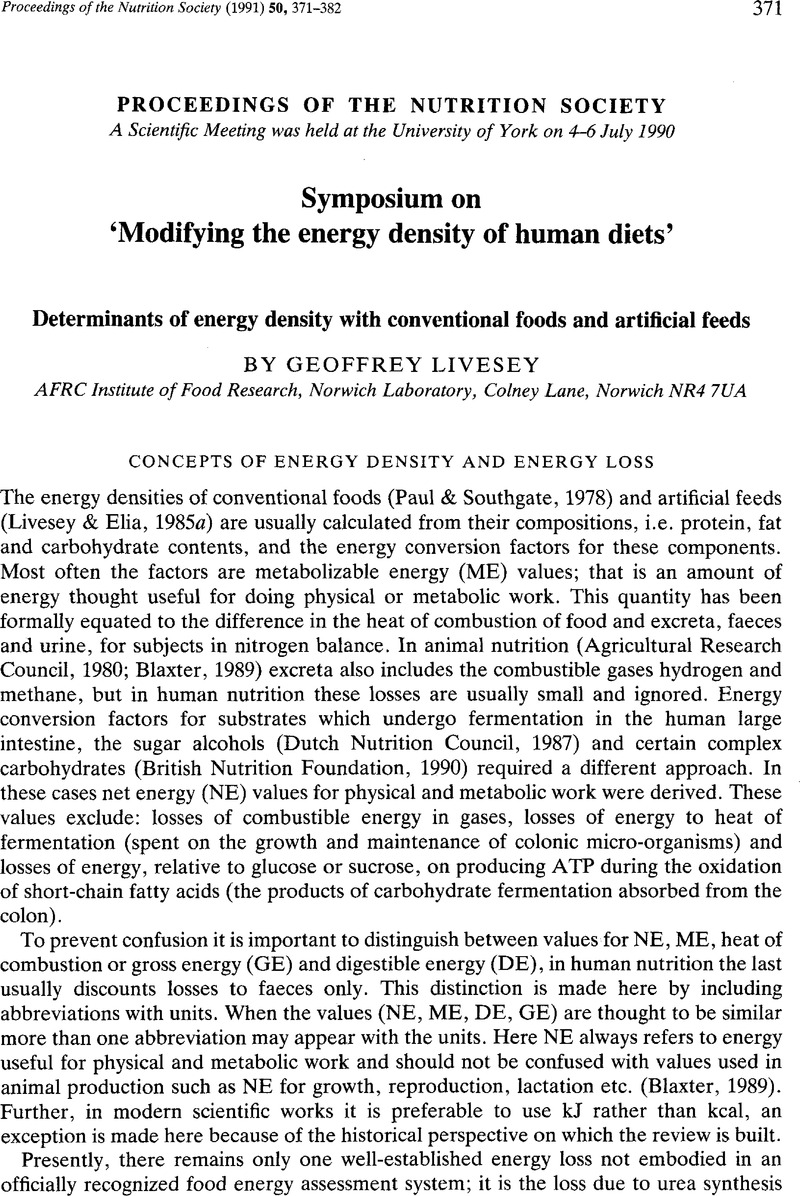Crossref Citations
This article has been cited by the following publications. This list is generated based on data provided by Crossref.
Livesey, Geoffrey
1991.
Implications of plant polysaccharides for human health, especially obesity.
Food Hydrocolloids,
Vol. 5,
Issue. 1-2,
p.
23.
Livesey, G.
1992.
The Energy Values of Dietary Fibre and Sugar Alcohols for Man.
Nutrition Research Reviews,
Vol. 5,
Issue. 1,
p.
61.
Annison, G.
Bertocchi, C.
and
Khan, R.
1993.
Low-Calorie Foods and Food Ingredients.
p.
53.
Livesey, Geoffrey
1993.
Comments on the methods used to determine the energy values of carbohydrates: Dietary fibre, sugar alcohols and other bulking agents.
International Journal of Food Sciences and Nutrition,
Vol. 44,
Issue. 4,
p.
221.
Brown, Jacqueline C.
and
Livesey, Geoffrey
1994.
Urinary energy excretion in rats fed guar gum: Implications for putative thermogenesis.
Food Hydrocolloids,
Vol. 8,
Issue. 1,
p.
69.
Livesey, G
1995.
Metabolizable energy of macronutrients.
The American Journal of Clinical Nutrition,
Vol. 62,
Issue. 5,
p.
1135S.
Ellwood, KC
1995.
Methods available to estimate the energy values of sugar alcohols.
The American Journal of Clinical Nutrition,
Vol. 62,
Issue. 5,
p.
1169S.
Mela, David J.
1997.
Fat and sugar substitutes: implications for dietary intakes and energy balance.
Proceedings of the Nutrition Society,
Vol. 56,
Issue. 3,
p.
827.
Wisker, Elisabeth
Knudsen, Knud Erik Bach
Daniel, Martina
Eggum, Björn O.
and
Feldheim, Walter
1997.
Energy Values of Non-Starch Polysaccharides: Comparative Studies in Humans and Rats.
The Journal of Nutrition,
Vol. 127,
Issue. 1,
p.
108.
Phillips, Glyn O.
1998.
Acacia gum (Gum Arabic): A nutritional fibre; metabolism and calorific value.
Food Additives and Contaminants,
Vol. 15,
Issue. 3,
p.
251.
Smith, Tracyn
Brown, Jacqueline C
and
Livesey, Geoffrey
1998.
Energy balance and thermogenesis in rats consuming nonstarch polysaccharides of various fermentabilities.
The American Journal of Clinical Nutrition,
Vol. 68,
Issue. 4,
p.
802.
Warwick, Penelope M.
and
Baines, Janis
2000.
Point of view: Energy factors for food labelling and other purposes should be derived in a consistent fashion for all food components.
British Journal of Nutrition,
Vol. 84,
Issue. 6,
p.
897.
GUENTHER, PATRICIA M
and
JENSEN, HELEN H
2000.
Estimating Energy Contributed by Fiber Using a General Factor of 2 vs 4 kcal/g.
Journal of the American Dietetic Association,
Vol. 100,
Issue. 8,
p.
944.
Livesey, Geoffrey
2001.
A perspective on food energy standards for nutrition labelling.
British Journal of Nutrition,
Vol. 85,
Issue. 3,
p.
271.
Chesson, Andrew
2006.
Food Polysaccharides and Their Applications.
p.
629.
Sharma, Alka
Yadav, Baljeet Singh
and
Ritika
2008.
Resistant Starch: Physiological Roles and Food Applications.
Food Reviews International,
Vol. 24,
Issue. 2,
p.
193.
Sihag, J.
and
Jones, P. J. H.
2018.
Oleoylethanolamide: The role of a bioactive lipid amide in modulating eating behaviour.
Obesity Reviews,
Vol. 19,
Issue. 2,
p.
178.





